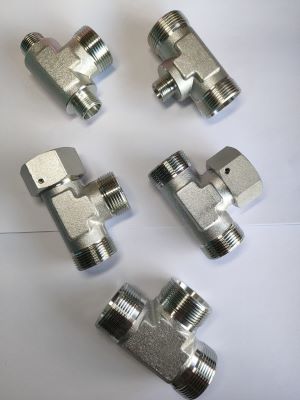In the realm of hydraulic systems, where precision and efficiency reign supreme, even the smallest components play a pivotal role in ensuring seamless operations. One such component that stands out for its importance is the hydraulic tee.
As we embark on this journey of understanding, we will unravel the mysteries surrounding hydraulic tees, addressing questions like “What is a hydro tee?” and “Can you tee a hydraulic line?” We hope to provide you a thorough understanding of hydraulic tees and their crucial function in hydraulic setups through this in-depth investigation.
What is a Hydraulic Tee?
A hydraulic tee, often referred to simply as a “tee,” is a fundamental component in hydraulic systems. Its design, which resembles the letter “T,” serves a critical purpose: it provides a means to create a branching connection within a hydraulic line. This branching connection enables the diversion of hydraulic fluid flow, making it a versatile and essential element in numerous hydraulic applications.
Key Characteristics of Hydraulic Tees
Design Variations: Hydraulic tees come in various designs, including equal tees and reducing tees. Equal tees maintain consistent diameter across all ports, while reducing tees accommodate different diameters to facilitate fluid flow adaptation.
Construction Materials: These tees are typically constructed from materials such as stainless steel, carbon steel, or other materials compatible with hydraulic fluids. The material choice depends on factors like fluid composition, pressure levels, and environmental conditions.
Thread Types: Just like other hydraulic components, thread types in hydraulic tees are crucial for ensuring secure connections. Common thread types include NPT (National Pipe Taper), BSPP (British Standard Pipe Parallel), and Metric threads.
Can You Tee a Hydraulic Line?
The concept of teeing a hydraulic line brings with it a blend of practicality and complexity. The answer to the question “Can you tee a hydraulic line?” lies in the understanding of hydraulic system dynamics, safety considerations, and the role that hydraulic tees play.
When to Use Hydraulic Tees
Branching Flow: Tees are indispensable when you need to split a hydraulic flow into two or more directions. This could be necessary for simultaneous operations or directing fluid to different components.
System Modifications: During modifications or upgrades to a hydraulic system, tees enable the incorporation of new components or the rerouting of lines without disrupting the entire setup.
Pressure Distribution: Tees aid in distributing hydraulic pressure evenly among connected components, preventing pressure imbalances that could lead to system inefficiencies.
Key Considerations for Teed Hydraulic Lines
Flow Division: When teeing a hydraulic line, it’s essential to consider the fluid flow distribution to ensure that each branch receives an appropriate volume of hydraulic fluid.
Pressure Differential: Different branches might experience varying pressure levels, depending on the demands of connected components. Ensuring suitable pressure levels in each branch is crucial.
Fluid Compatibility: The hydraulic fluid’s composition and compatibility with materials used in the hydraulic tee are crucial factors in maintaining system integrity.
Choosing the Right Hydraulic Tee
Selecting the correct hydraulic tee involves a thoughtful analysis of the system’s requirements and operational conditions. Some factors to consider include:
Port Sizes: Ensure that the tee’s port sizes match the existing hydraulic lines’ diameters to facilitate smooth fluid flow.
Materials: Choose a hydraulic tee material that aligns with the hydraulic fluid’s composition, system pressure, and environmental factors.
Thread Compatibility: Opt for a hydraulic tee with thread types compatible with the rest of the hydraulic components to ensure a secure connection.
Conclusion
The hydraulic tee, unassuming in appearance yet indispensable in function, plays a pivotal role in hydraulic systems’ intricate dance. It enables branching connections, supports fluid flow distribution, and empowers the customization of hydraulic setups. Understanding its nuances, choosing the right hydraulic tee, and adhering to proper installation practices contribute to the overall efficiency and longevity of hydraulic systems.
Post time: Sep-01-2023


